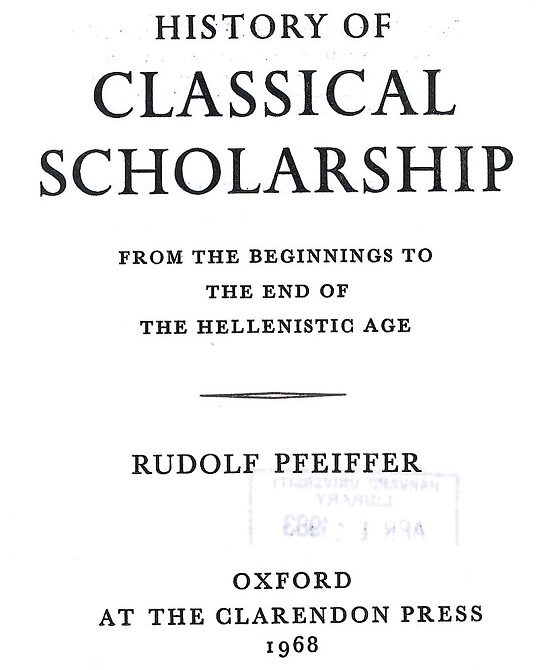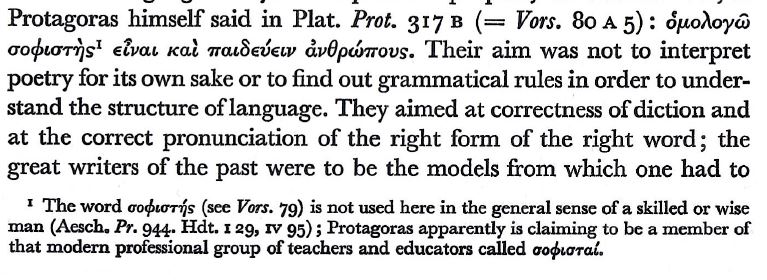‘The Sophistic movement of the fifth century holds a unique position in the history of the ancient world”
THE SOPHISTS, THEIR CONTEMPORARIES, AND PUPILS
IN THE FIFTH AND FOURTH CENTURIES

Chapter 2
The Sophistic movement of the fifth century holds a unique position in the history of the ancient world; it never repeated itself, and, in a historical sense, one should not speak of a ‘second Sophistic’ in Roman times. The part it played in the early history (or prehistory) of classical scholarship was an intermediary one. The Sophists were linked with the past in so far as they developed their ideas out of hints in earlier literature ; so we have always to look back to poetry as well as to philosophy and history. On the other hand, they were the first to influence by their theories not only prose writing, rhetoric, and dialectic above all, but also contemporary and later poetry; so they force us to look ahead.
The Sophists can be regarded, in a sense, as the heirs of the rhapsodes. They also came from every part of the Hellenic world and wandered through all the Greek-speaking lands; but in the age after the expulsion of the tyrants and the defeat of the Persian invader their ways quite naturally converged on Athens, the leading democratic city-state, where they could gather their best pupils around them. The Sophists explained epic and archaic poetry, combining their interpretations with linguistic observations, definitions, and classifications on the lines laid down by previous philosophers; but their interest in Homeric or lyric poetry as well as in language always had a practical purpose, ‘to educate men’, as

learn. In that way they became the ancestors of the virtuosi in the literary field. If scholarship were a mere artifice, they would indeed have been its pioneers;1 for they invented and taught a number of very useful tricks and believed that such technical devices could do everything. But for this very reason they do not deserve the name of ‘scholars’—they would not even have liked it. Still less should they be termed ‘humanists’ ;2 Sophists concerned themselves not with the values that imbue man’s conduct with ‘humanitas’, but with the usefulness of their doctrine or technique for the individual man, especially in political life.
Some examples, drawn from individual aspects of their activity, will be given later; we shall look at the Sophistic practice of interpretation, analysis of language, literary criticism, antiquarian lore, and polymathy.
However, there is one of their services to future scholarship on which we have to dwell a little longer; and for that reason we take it first. The very existence of scholarship depends on the book,3 and books seem to have come into common use in the course of the fifth century, particularly as the medium for Sophistic writings. Early Greek literature had to rely on oral tradition, it had to be recited and to be heard; even in the fifth and fourth centuries there was a strong reaction against the inevitable transition from the spoken to the written word; only the civilization of the third century can be called—and not without exaggeration— a ‘bookish’ one.4
This may be the right moment for having a look at ‘the oriental background’ against which the whole of Greek culture had arisen, in so far as it is relevant for Greek scholarship. While aware of this historical process, I am, naturally enough, rather reluctant to speak of it as I have not the slightest acquaintance with the languages concerned; so I am forced to rely on the reports and interpretations of specialists and to draw conclusions from them with due reserve.
Excavations in Mesopotamia5 revealed the early existence not only of archives with documents on clay tablets, but also of ‘libraries’ with literary texts. From about 2800 b.g., so we are told, the Sumerianspeaking inhabitants maintained record offices as well as libraries and schools in connexion with the temples of their gods.
1 P. B. R. Forbes, ‘Greek Pioneers in Philology and Grammar’, Cl.R. 47 (1933) 105 ff., gives a useful short survey of some achievements of the Sophists; but they were not ‘pioneers’ in scholarship in the strict sense of the word, as it is used here.
2 W. Jaeger, Paideia I (1934) 377, 380 f.
3 The elder Pliny went even further, when he said (h.n. xm 68): ‘cum chartae usu maxime humanitas vitae constet, certe memoria’; hardly any Greek would have gone as far as that (see below, p. 32).
4 See below, p. 102.
3 Eduard Meyer, Geschichte des Altertums 12s (1926) 334 ff. (§§312 ff.) (in particular pp. 335 f., 340, 342 f.). A more recent survey with a new chronology and extensive bibliography is given by A. Moortgat, ‘Geschichte Vorderasiens bis zum Hellenismus’, in A. Scharff und A. Moortgat, Agypten und. Vorderasien im Altertum (Munchen 1950) 93-535, esp. 315 ff., 471 ff.— Handbuch, der Bibliotheksmssenschafi2, hg. von G. Leyh, m 1 (1955) I-5°5 F. Milkau u. F. Schawe, ‘Der alte Vorderorient’ on libraries in Egypt and in the Near East; on writing see also vol. I2 (1952) 1-105. For the use of writing in Mesopotamia see Kenyon Books and Readers 6 f.—On the early stimulating influence of Mesopotamian writing on Egypt see H. Frankfort, The Birth of Civilisation in the Near East (London 1951) 106 f.
814342
The keepers of the clay tablets who had to preserve the precious texts attached importance to the exact wording of the originals and tried to correct mistakes of the copyists; for that reason they even compiled ‘glossaries’ of a sort. Towards the end of the third millennium Semitic invaders from the north (the Babylonians, as they were afterwards called) adopted the Sumerian methods of preservation and also made lists containing the Sumerian words and their Accadian equivalents. In the course of the second millennium the Hittites conquered large parts of Anatolia; there are cuneiform tablets found in their capital Bogaskby showing in three parallel columns equivalent words in Hittite, Sumerian, and Accadian.1 Similar discoveries, dating from the second half of the second millennium, were made during the excavations of Ugarit (Ras-Shamra) in northern Syria. In the seventh century b.c. much of the earlier, especially the ‘Babylonian’, tradition was copied for the palace-library of the great Assyrian king Assurbanipal, who was no less proud of his writing abilities than of his conquests; there are more than 20,000 tablets and fragments in the British Museum.
His learned scribes had inherited a truly refined technique and they developed it further in the descriptive notes at the end of each tablet.2 Without romantic exaggeration we can say that these scribes felt a ‘religious’ responsibility for the correct preservation of the texts, because all of them had to be regarded as sacred in a certain sense.3 Their complicated method of ‘cataloguing’ was invented for the particular writing material, the clay tablets, and the lists of words from different languages were a product of the singular historical conditions of Mesopotamia and the surrounding countries. But no ‘scholarship’ emerged from those descriptive notes and parallel glossaries, which served only the practical needs of the archives, libraries, and schools of temples. We find much the same in other fields: the extensive oriental ‘annals’ did not lead to a methodical writing of history.
1 For recent excavations of clay tablets with important texts in Accadian and translation into Hittite see K. Bittel, ‘Ausgrabungen in Bogazkoy’ (1952-7) in Neue deutsche Ausgrabungen im Mittelmeergebiet und im vorderen Orient (Berlin 1959) 108.
2 Full details are given by C. Wendel, ‘Buchbeschreibung’, 2 ff.
3 Cf. E. Meyer, loc. cit. 462 f., 583 ff., 597 f. (religion and literature); C. Wendel 11 (but the kings were not gods as in Egypt).
for more:
Download FULL CHAPTER
